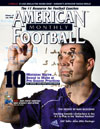AMERICAN FOOTBALL MONTHLY THE #1 RESOURCE FOR FOOTBALL COACHES
Article CategoriesAFM Magazine
|
10 Mistakes You\'re Bound to Make at Pre-Season PracticesGlenn Caruso\'s top ten mistakes coaches commit when planning pre-season campby: Mike Kuchar Senior Writer, American Football Monthly © More from this issue So the summer is winding down and you’ve put a stamp on your off-season conditioning; wrapped up the local seven on seven tournaments; and made all the necessary arrangements to have an intense and productive camp in preparation for another eventful season. But as the lazy days of July morph into the intensely crammed early days of August, there are some major concerns that need to be addressed before heading into summer camp. Sure, every good coach has a plan, but there are some major decisions to be made before putting that plan into action. Will you travel to a neutral location or have camp at your school? How many practices a day will you hold? How much conditioning should be organized? How will you delegate coaching assignments? When will you give the kids a day off? How will you deal with the summer heat? These are....The full article can only be seen by subscribers. Subscribe today!
|
|
|||||||
| HOME |
MAGAZINE |
SUBSCRIBE | ONLINE COLUMNISTS | COACHING VIDEOS |
Copyright 2025, AmericanFootballMonthly.com
All Rights Reserved





